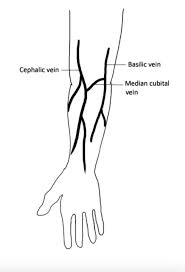Which of the following parameters should a phlebotomist consider when selecting a blood collection method?
Patient condition, patient age, blood volume required
Patient height, patient gender, patient medications
Ordering physician, number of tests ordered, diagnosis
Time of day, timing of specimen, test status
The Correct Answer is A
Choice A Reason:
The patient's condition is a critical factor as it can influence the ease of blood collection and the choice of collection site. For example, a dehydrated patient may have less accessible veins. Patient age is also important; pediatric and geriatric patients may require different approaches due to vein size and fragility. The blood volume required for testing must be considered to ensure sufficient sample size without compromising patient safety, adhering to guidelines that limit blood collection to a certain percentage of the patient's total blood volume.
Choice B Reason:
While patient height and gender may influence the choice of blood collection site, they are not as critical as the factors listed in choice A. Patient medications are important to consider, as some medications may affect coagulation or the integrity of the sample.
Choice C Reason:
The ordering physician's preferences may be considered, but they are not a primary factor in the method of collection. The number of tests ordered and the diagnosis can influence the volume of blood needed but are secondary to the patient's condition and safety considerations.
Choice D Reason:
The time of day and the timing of the specimen collection can be important for certain tests that are time-sensitive or influenced by diurnal variations. The test status, whether routine or stat, may affect the urgency of collection but not necessarily the method of collection.
Nursing Test Bank
Naxlex Comprehensive Predictor Exams
Related Questions
Correct Answer is A
Explanation
Choice A Reason:
The median cubital vein is often the first choice for venipuncture due to its size and accessibility. It is located in the antecubital fossa and is usually well anchored by surrounding tissues, which makes it less likely to roll during needle insertion. This vein is also less painful for patients when punctured due to its location and the type of surrounding tissue.
Choice B Reason:
The basilic vein is another option for venipuncture, but it is not typically the first choice. It is located on the medial aspect (inner side) of the arm and is more prone to rolling and injury because it is not as well anchored as the median cubital vein. Additionally, the basilic vein is located near nerves and arteries, which increases the risk of complications during venipuncture.
Choice C Reason:
The cephalic vein runs along the lateral aspect (outer side) of the arm and can be used for venipuncture. However, it is often more difficult to locate and has a tendency to roll, which can make venipuncture more challenging. It is usually considered after the median cubital vein.
Choice D Reason:
Veins on the underside of the wrist should generally be avoided for routine venipuncture because they are often smaller, can be more painful due to the proximity to nerves and tendons, and have a higher risk of complications. These veins are considered only when other sites are not available or are unsuitable for venipuncture.

Correct Answer is A
Explanation
Choice A reason:
The date of specimen collection is crucial for a laboratory report as it provides the context for the test results. It helps in assessing the timeliness and relevance of the results, especially when monitoring conditions that can change rapidly over time.
Choice B reason:
While the phlebotomist's initials may be recorded as part of the internal process for tracking specimen collection, they are not typically included in the patient's laboratory report. The focus of the report is on the patient and the test results, rather than on the personnel who collected the sample.
Choice C reason:
Patient diagnosis is not usually included in a laboratory report because the purpose of the report is to provide test results that may inform a diagnosis. The diagnosis is made by the healthcare provider based on the test results, along with other clinical information.
Choice D reason:
Values of previous tests may be referenced in a patient's medical record but are not a required element on a laboratory report. Each report typically presents the results of the current tests only. Comparisons to previous values, if needed, are made by the healthcare provider.
Whether you are a student looking to ace your exams or a practicing nurse seeking to enhance your expertise , our nursing education contents will empower you with the confidence and competence to make a difference in the lives of patients and become a respected leader in the healthcare field.
Visit Naxlex, invest in your future and unlock endless possibilities with our unparalleled nursing education contents today
Report Wrong Answer on the Current Question
Do you disagree with the answer? If yes, what is your expected answer? Explain.
Kindly be descriptive with the issue you are facing.
